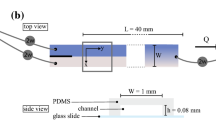Abstract
The Stokes-Einstein (SE) relation has been considered as one of the hallmarks of dynamics in liquids. It describes that the diffusion constant D is proportional to (τ/T)−1, where τ is the structural relaxation time and T is the temperature. In many glass-forming liquids, the breakdown of SE relation often occurred when the dynamics of the liquids becomes glassy, and its origin is still debated among many scientists. Using molecular dynamics simulations and support-vector machine method, it is found that the scaling between diffusion and relaxation fails when the total population of solid-like clusters shrinks at the maximal rate with decreasing temperature, which implies a dramatic unification of clusters into an extensive dominant one occurs at the time of breakdown of the SE relation. Our data leads to an interpretation that the SE violation in metallic glass-forming liquids can be attributed to a specific change in the atomic structures.
Similar content being viewed by others
References
P. G. Debenedetti, and F. H. Stillinger, Nature 410, 259 (2001).
W. H. Wang, Prog. Mater. Sci. 106, 100561 (2019).
J. C. Qiao, Q. Wang, J. M. Pelletier, H. Kato, R. Casalini, D. Crespo, E. Pineda, Y. Yao, and Y. Ysang, Prog. Mater. Sci. 104, 250 (2019).
Z. W. Wu, W. Kob, W. H. Wang, and L. Xu, Nat. Commun. 9, 5334 (2018), arXiv: 1808.04084.
P. Luo, Y. Z. Li, H. Y. Bai, P. Wen, and W. H. Wang, Phys. Rev. Lett. 116, 175901 (2016).
T. Scopigno, G. Ruocco, F. Sette, and G. Monaco, Science 302, 849 (2003), arXiv: cond-mat/0311305.
L. Wang, A. Ninarello, P. Guan, L. Berthier, G. Szamel, and E. Flenner, Nat. Commun. 10, 26 (2019), arXiv: 1804.08765.
T. Kawasaki, and K. Kim, Sci. Adv. 3, e1700399 (2017), arXiv: 1701.06028.
Y. C. Hu, F. X. Li, M. Z. Li, H. Y. Bai, and W. H. Wang, J. Appl. Phys. 119, 205108 (2016).
R. Soklaski, V. Tran, Z. Nussinov, K. F. Kelton, and L. Yang, Philos. Mag. 96, 1212 (2016), arXiv: 1502.01739.
L. Xu, F. Mallamace, Z. Yan, F. W. Starr, S. V. Buldyrev, and H. Eugene Stanley, Nat. Phys. 5, 565 (2009).
S. Sastry, and C. Austen Angell, Nat. Mater. 2, 739 (2003).
F. H. Stillinger, and J. A. Hodgdon, Phys. Rev. E 50, 2064 (1994).
G. Tarjus, and D. Kivelson, J. Chem. Phys. 103, 3071 (1995).
S. R. Becker, P. H. Poole, and F. W. Starr, Phys. Rev. Lett. 97, 055901 (2006), arXiv: cond-mat/0605170.
S. Pan, Z. W. Wu, W. H. Wang, M. Z. Li, and L. Xu, Sci. Rep. 7, 39938 (2017).
S. S. Schoenholz, E. D. Cubuk, D. M. Sussman, E. Kaxiras, and A. J. Liu, Nat. Phys. 12, 469 (2016).
Y. T. Sun, H. Y. Bai, M. Z. Li, and W. H. Wang, J. Phys. Chem. Lett. 8, 3434 (2017).
S. Plimpton, J. Comput. Phys. 117, 1 (1995).
M. I. Mendelev, D. J. Sordelet, and M. J. Kramer, J. Appl. Phys. 102, 043501 (2007).
W. Kob, and H. C. Andersen, Phys. Rev. E 52, 4134 (1995), arXiv: cond-mat/9505118.
Author information
Authors and Affiliations
Corresponding author
Electronic supplementary material
11433_2020_1539_MOESM1_ESM.pdf
Supplementary Information for “Revisiting the structural signature of breakdown of Stokes-Einstein relation in a glass-forming liquid with machine learning”
Rights and permissions
About this article
Cite this article
Wu, Z., Li, R. Revisiting the breakdown of Stokes-Einstein relation in glass-forming liquids with machine learning. Sci. China Phys. Mech. Astron. 63, 276111 (2020). https://doi.org/10.1007/s11433-020-1539-4
Received:
Accepted:
Published:
DOI: https://doi.org/10.1007/s11433-020-1539-4




